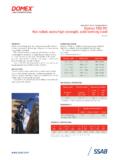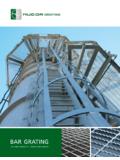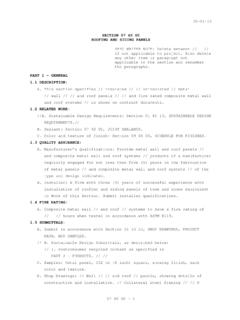Transcription of Standard Practice for Safeguarding Against Embrittlement ...
1 Designation: A143/A143M 07. Standard Practice for Safeguarding Against Embrittlement of Hot- dip galvanized Structural Steel Products and Procedure for Detecting Embrittlement1. This Standard is issued under the fixed designation A143/A143M; the number immediately following the designation indicates the year of original adoption or, in the case of revision, the year of last revision. A number in parentheses indicates the year of last reapproval. A superscript epsilon ( ) indicates an editorial change since the last revision or reapproval. This Standard has been approved for use by agencies of the Department of Defense. 1. Scope F606 Test Methods for Determining the Mechanical Prop- This Practice covers procedures that can be followed to erties of Externally and Internally Threaded Fasteners, safeguard Against the possible Embrittlement of steel hot-dip Washers, Direct Tension Indicators, and Rivets galvanized after fabrication, and outlines test procedures for 3. Terminology detecting Embrittlement .
2 Conditions of fabrication may induce a susceptibility to Embrittlement in certain steels that can be Definition: accelerated by galvanizing. Embrittlement is not a common Embrittlement , n the loss or partial loss of ductility in occurrence, however, and this discussion does not imply that a steel where an embrittled product characteristically fails by galvanizing increases Embrittlement where good fabricating fracture without appreciable deformation; types of embrittle- and galvanizing procedures are employed. Where history has ment usually encountered in galvanized steel are related to shown that for specific steels, processes and galvanizing aging phenomena, cold working, and absorption of hydrogen. procedures have been satisfactory, this history will serve as an 4. Factors in Embrittlement indication that no Embrittlement problem is to be expected for those steels, processes, and galvanizing procedures. Embrittlement or loss of ductility in steel is often This Practice is applicable in either inch-pounds or SI associated with strain-aging.
3 Strain-aging refers to the delayed units. Inch-pounds and SI units are not necessarily exact increase in hardness and strength, and loss of ductility and equivalents. Within the text of this Practice and where appro- impact resistance which occur in susceptible steels as a result priate, SI units are shown in brackets. of the strains induced by cold working. The aging changes This Standard does not purport to address all of the proceed slowly at room temperature, but proceed at an accel- safety concerns, if any, associated with its use. It is the erated rate as the aging temperature is raised and may occur responsibility of the user of this Standard to establish appro- rapidly at the galvanizing temperature of approximately 850 F. priate safety and health practices and determine the applica- [455 C]. bility of regulatory limitations prior to use. Hydrogen Embrittlement may also occur due to the possibility of atomic hydrogen being absorbed by the steel. The 2. Referenced Documents susceptibility to hydrogen Embrittlement is influenced by the ASTM standards :2 type of steel, its previous heat treatment, and degree of previous cold work.
4 In the case of galvanized steel, the acid pickling reaction prior to galvanizing presents a potential 1. This Practice is under the jurisdiction of ASTM Committee A05 on Metallic- source of hydrogen. However, the heat of the galvanizing bath Coated Iron and Steel Products and is the direct responsibility of Subcommittee on Structural Shapes and Hardware Specifications. partially expels hydrogen that may have been absorbed. In Originally Prepared by Subcommittee on Embrittlement Investigation of Practice hydrogen Embrittlement of galvanized steel is usually Committee A05 on Corrosion of Iron and Steel and based on an investigation made of concern only if the steel exceeds approximately 150 ksi by Battelle Memorial Institute under American Society for Testing and Materials' [1100 MPa] in ultimate tensile strength, or if it has been sponsorship. See Proceedings, Am. Soc. Testing Mats., Vol 31, Part I, 1931, p. 211;. also paper by Samuel Epstein, Embrittlement of Hot- dip galvanized Structural severely cold worked prior to pickling.
5 Steel, see Proceedings , Am. Soc. Testing Mats., Vol 32, Part II, 1932, p. 293. Loss of ductility of cold-worked steels is dependent on Current edition approved May 1, 2007. Published June 2007. Originally many factors including the type of steel (strength level, aging approved in 1932. Last previous edition approved in 2003 as A143/A143M - 03. DOI: characteristics), thickness of steel, and degree of cold work, 2. For referenced ASTM standards , visit the ASTM website, , or and is accentuated by areas of stress concentration such as contact ASTM Customer Service at For Annual Book of ASTM caused by notches, holes, fillets of small radii, sharp bends, etc. standards volume information, refer to the Standard 's Document Summary page on the ASTM website. Copyright ASTM International, 100 Barr Harbor Drive, PO Box C700, West Conshohocken, PA 19428-2959, United States. 1. A143/A143M 07. Low temperatures increase the risk of brittle failure of 7. Preparation for Galvanizing all plain carbon steels including steel that has been galvanized .
6 Hydrogen can be absorbed during pickling and in some The rate at which this temperature loss of ductility occurs instances, as noted in , may contribute to Embrittlement of varies for different steels. The expected service temperature the galvanized product. The likelihood of this, or of surface should thus be taken into account when selecting the steel. cracking occurring, is increased by excessive pickling tempera- ture, prolonged pickling time, and poor inhibition of the 5. Steels pickling acid. Heating to 300 F [150 C] after pickling and Open-hearth, basic-oxygen, and electric-furnace steels before galvanizing in most cases results in expulsion of shall be used for galvanizing. Other materials that can be hydrogen absorbed during pickling. galvanized include continuous cast slabs, steel or iron castings, Abrasive blast cleaning followed by flash pickling may and wrought iron. also be employed when over-pickling is of concern or when very high strength steel, ultimate tensile strength higher than 6.
7 Cold Working and Thermal Treatment 150 ksi [1100 MPa], must be galvanized . The abrasive blast For intermediate and heavy shapes, plates, and hard- cleaning does not generate hydrogen while it is cleaning the ware, cold bend radii should not be less than that which is surface of the steel. The flash pickling after abrasive blast proven satisfactory by Practice or by the recommendations of cleaning is used to remove any final traces of blast media the steel manufacturer. These criteria generally depend on the before hot-dip galvanizing. direction of grain, strength, and type of steel. A cold bending 8. Responsibility for Avoiding Embrittlement radius of three times (33) the section thickness, or as recom- mended in AISC Manual of Steel Construction,3 will ordinarily Design of the product and selection of the proper steel to ensure satisfactory properties in the final product. Although withstand normal galvanizing operations without embrittle- sharper bending on thin sections can usually be tolerated, ment are the responsibility of the designer.
8 The fabricator shall Embrittlement may occur if cold bending is especially severe. be responsible for employing suitable fabrication procedures. If the design requires sharper bending than discussed herein, The galvanizer shall employ proper pickling and galvanizing the bending should be done hot, or if done cold the material procedures. should be subsequently annealed or stress relieved as noted in 9. Testing for Embrittlement of Steel Shapes, Steel Smaller shapes, including thickness up to 1 4 in. [ Castings, Threaded Articles, and Hardware Items mm] may be cold worked by punching without subsequent Subject to base material and dimensional limitations, the annealing or stress-relieving. Shapes 5 16 to 11 16 in. [8 to 18 tests given in , , , or , or a combination thereof, mm] in thickness are not seriously affected as to serviceability shall apply. If one test specimen should be found embrittled by by cold punching or if the punching is done under good shop these tests, two additional specimens should be tested.
9 Failure Practice . The heavier shapes, 3 4 in. [19 mm] and over, shall be of either the second or the third specimen shall be cause for reamed with at least 1 16 in. [ mm] of metal removed from rejection of the lot (see Note 1) that the samples represent. the periphery of the hole after punching, or shall be drilled, or NOTE 1 A lot is a unit of production from which a sample may be thermally treated prior to galvanizing as noted in taken for testing. Unless otherwise agreed upon by the manufacturer and Fabrication in accordance with the principles outlined in the purchaser, or established within this Practice , the lot shall be as and will normally obviate the need for thermal follows: For test at a manufacturer's facility, a lot is one or more articles treatment. However, if required, proper thermal treatment shall of the same type and size comprising a single order or a single delivery precede galvanizing of the steel. For heavy cold deformation load, whichever is the smaller, or a smaller number of articles identified as a lot by the manufacturer, when these have been galvanized within a single exemplified by cold rolling, sheared edges, punched holes, or production shift.
10 For test by purchaser after delivery, the lot consists of the cold-formed rods and bolts, subcritical annealing at tempera- single order or the single delivery load, whichever is the smaller, unless tures from 1200 to 1300 F [650 to 705 C] should be employed. the lot identity, established in accordance with the above, is maintained For less severe cold deformation typified by cold bending, roll and clearly indicated in the shipment by the manufacturer. forming, etc., it is advisable to limit the thermal treatment to A bend test for Embrittlement of galvanized steel hard- stress relieving at a maximum of 1100 F [595 C] to avoid ware such as bolts, pole and tower steps, braces, rods, excessive grain growth or alternatively to fully normalize the reinforcing bars, etc., consists of bending the article and steel at temperatures from 1600 to 1700 F [870 to 925 C]. The comparing the degree of bending to that which is obtained on time at temperature should be approximately 1 h/in. [24 a similar ungalvanized article.]







